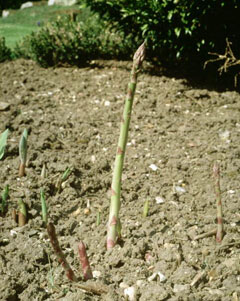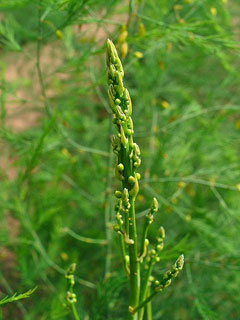 |
|
http://commons.wikimedia.org/wiki/File:Illustration_Asparagus_officinalis0_clean.jpg |
 |
| http://commons.wikimedia.org/wiki/File:Asparagus_officinalis_002.JPG |
Translate this page:
Summary
Physical Characteristics

 Asparagus officinalis is a PERENNIAL growing to 1.5 m (5ft) by 0.8 m (2ft 7in) at a slow rate.
Asparagus officinalis is a PERENNIAL growing to 1.5 m (5ft) by 0.8 m (2ft 7in) at a slow rate.
See above for USDA hardiness. It is hardy to UK zone 4 and is not frost tender. It is in flower in August, and the seeds ripen from September to October. The species is dioecious (individual flowers are either male or female, but only one sex is to be found on any one plant so both male and female plants must be grown if seed is required). and is pollinated by Bees. The plant is not self-fertile.
It is noted for attracting wildlife.
Suitable for: light (sandy), medium (loamy) and heavy (clay) soils and prefers well-drained soil. Suitable pH: mildly acid, neutral and basic (mildly alkaline) soils and can grow in very acid, very alkaline and saline soils.
It can grow in semi-shade (light woodland) or no shade. It prefers moist soil. The plant can tolerate maritime exposure.
UK Hardiness Map
US Hardiness Map
Synonyms
Plant Habitats
Cultivated Beds;
Edible Uses
Edible Parts: Shoots Stem
Edible Uses: Coffee
Young shoots - raw or cooked[2, 5, 15, 16, 27, K]. Considered a gourmet food[132], the shoots are harvested in the spring. We find them very acceptable raw in salads, with a hint of onion in their flavour[K]. They are normally boiled or steamed and used as a vegetable[K]. Male plants produce the best shoots[1]. Do not over-harvest the plant because this would weaken it in the following year. The shoots are a good source of protein and dietary fibre[201]. Roasted seeds are a coffee substitute[21, 46, 183].
References More on Edible Uses
| Composition
|
| Figures in grams (g) or miligrams (mg) per 100g of food.
|
|
|
Stem (Fresh weight)
|
|
- 26 Calories per 100g
- Water : 91.7%
- Protein: 2.5g; Fat: 0.2g; Carbohydrate: 5g; Fibre: 0.7g; Ash: 0.6g;
- Minerals - Calcium: 22mg; Phosphorus: 62mg; Iron: 1mg; Magnesium: 0mg; Sodium: 2mg; Potassium: 278mg; Zinc: 0mg;
- Vitamins - A: 540mg; Thiamine (B1): 0.18mg; Riboflavin (B2): 0.2mg; Niacin: 1.5mg; B6: 0mg; C: 33mg;
- Reference: [ 218]
- Notes:
|
|
Medicinal Uses
Plants For A Future can not take any responsibility for any adverse effects from the use of plants. Always seek advice from a professional before using a plant medicinally.
Antibiotic Antispasmodic Aperient Cancer Cardiac Demulcent Diaphoretic Diuretic
Laxative Sedative Tonic Urinary
Asparagus has been cultivated for over 2,000 years as a vegetable and medicinal herb[238]. Both the roots and the shoots can be used medicinally, they have a restorative and cleansing effect on the bowels, kidneys and liver[238]. The plant is antispasmodic, aperient, cardiac, demulcent, diaphoretic, diuretic, sedative and tonic[4, 21, 165, 201, 240]. The freshly expressed juice is used[4]. The root is diaphoretic, strongly diuretic and laxative[9, 218, 222]. An infusion is used in the treatment of jaundice and congestive torpor of the liver[240]. The strongly diuretic action of the roots make it useful in the treatment of a variety of urinary problems including cystitis[254]. It is also used in the treatment of cancer[218]. The roots are said to be able to lower blood pressure[7, 222]. The roots are harvested in late spring, after the shoots have been cut as a food crop, and are dried for later use[7]. The seeds possess antibiotic activity[222]. Another report says that the plant contains asparagusic acid which is nematocidal and is used in the treatment of schistosomiasis[238].
References More on Medicinal Uses
The Bookshop: Edible Plant Books
Our Latest books on Perennial Plants For Food Forests and Permaculture Gardens in paperback or digital formats.

Edible Tropical Plants
Food Forest Plants for Hotter Conditions: 250+ Plants For Tropical Food Forests & Permaculture Gardens.
More

Edible Temperate Plants
Plants for Your Food Forest: 500 Plants for Temperate Food Forests & Permaculture Gardens.
More

More Books
PFAF have eight books available in paperback and digital formats. Browse the shop for more information.
Shop Now
Other Uses
Insecticide
Asparagus can be used in agroforestry as a perennial vegetable crop. It can be interplanted with other species and can serve as a ground cover that helps suppress weeds.
The plant contains asparagusic acid, which has nematocidal properties[238]. 1. Nectary - Flowers rich in nectar and pollen:
No – While asparagus does produce flowers, they are not particularly rich in nectar or pollen compared to other flowering plants.
2. Wildlife - Food (Fruit, Seeds, Leaf litter, Shelter, Nesting, Roosting):
Yes – The young shoots are edible for humans and can attract wildlife; however, the plant itself does not provide significant food or shelter directly for larger wildlife.
3. Invertebrate Shelter (Overwintering sites, Leaf litter, Groundcover):
Yes – Asparagus plants can offer some shelter through their foliage, and leaf litter can provide overwintering sites for invertebrates.
4. Pest Confuser (Smell):
No – Asparagus is not specifically known for having a strong smell that would confuse pests.
Special Uses
Attracts Wildlife Food Forest
References More on Other Uses
Cultivation details
Easily grown in any good garden soil[16]. Prefers a rich well-drained sandy loam and a sunny position[1, 16, 27, 238]. Prefers a pH of 6.5 or higher[200], though it tolerates a pH in the range 4.3 to 8.2. Asparagus is often cultivated as a luxury vegetable, there are some named varieties[16, 183]. Well-tended plants can be long-lived, an asparagus bed can last for well over 20 years. Asparagus is a good companion plant for tomatoes, parsley and basil[18, 20, 201]. When grown together, tomatoes help to protect asparagus from the asparagus beetle[201]. Asparagus is said to repel the nematodes that can infect tomatoes[201] (see the report below on the plants other uses). A good bee plant[108]. Dioecious. Male and female plants must be grown if seed is required. The plant is heat tolerant in zones 8 through 1. (Plant Hardiness Zones show how well plants withstand cold winter temperatures.
Plant Heat Zones show when plants would start suffering from the heat.
The Plant Heat Zone map is based on the number of "heat days" experienced in a given area where the temperature climbs to over 86 degrees F (30°C).
At this temperature, many plants begin to suffer physiological damage. Heat Zones range from 1 (no heat days) to 12 (210 or more heat days).
For example, Heat Zone. 11-1 indicates the plant is heat tolerant in zones 11 through 1.) For polyculture design and the above-ground architecture (form - tree, shrub, etc. and size shown above), information on the habit and root pattern is also useful and given here if available. The plant growth habit is a clumper with limited spread [1-2]. The root pattern is rhizomatous, with underground stems sending roots and shoots along their length [1-2]. Asparagus is typically harvested in spring, when the spears are young and tender. Asparagus flowers in late spring to early summer. Asparagus has a slow establishment phase, typically taking about 2 to 3 years to start producing a significant harvest. Once established, it can produce for many years, with vigorous growth in the spring.
References Carbon Farming Information and Carbon Sequestration Information
Temperature Converter
Type a value in the Celsius field to convert the value to Fahrenheit:
Fahrenheit:
The PFAF Bookshop
Plants For A Future have a number of books available in paperback and digital form. Book titles include Edible Plants, Edible Perennials, Edible Trees,Edible Shrubs, Woodland Gardening, and Temperate Food Forest Plants. Our new book is Food Forest Plants For Hotter Conditions (Tropical and Sub-Tropical).
Shop Now
Plant Propagation
Seed - pre-soak for 12 hours in warm water and then sow in spring or as soon as the seed is ripe in early autumn in a greenhouse. It usually germinates in 3 - 6 weeks at 25°c[134]. Prick out the seedlings into individual pots when they are large enough to handle and grow them on in a sunny position in the greenhouse for their first winter. Plant them out into their permanent positions in late spring or early summer[K]. Division in early spring as the plant comes into growth.
Other Names
If available other names are mentioned here
Native Range
TEMPERATE ASIA: Altay, Armenia, Azerbaijan, China, Ciscaucasia, Dagestan, Georgia, Gorno-Altay, Hakasija, Iran, Kazakhstan, Krasnoyarsk (south), Kurganskaja oblast, Lebanon, Mongolia, Novosibirsk, Omsk, Respublika, Russian Federation, Russian Federation,
Russian Federation-Ciscaucasia, Syria, Turkey, Tyumen (south), Xinjiang Uygur Zizhiqu (northwest),Afghanistan. EUROPE: Denmark (south), Czechoslovakia (Czech Republic and Slovakia), Austria, Belgium, Switzerland, Germany, Hungary,
Netherlands, Poland, Belarus, Moldova, Russian Federation, Kalmykija, Respublika, Astrakhan, Saratov, Volgogradskaja oblast, Ukraine (incl. Krym), Former Yugoslavia, Albania, Bulgaria, Greece, Italy (incl. Sicily), Romania, Spain, France (incl. Corsica), Portugal, AFRICA: Algeria, Morocco, Tunisia.
Weed Potential
Right plant wrong place. We are currently updating this section.
Please note that a plant may be invasive in one area but may not in your area so it's worth checking.
Conservation Status
IUCN Red List of Threatened Plants Status :

Growth: S = slow M = medium F = fast. Soil: L = light (sandy) M = medium H = heavy (clay). pH: A = acid N = neutral B = basic (alkaline). Shade: F = full shade S = semi-shade N = no shade. Moisture: D = dry M = Moist We = wet Wa = water.
Now available:
Food Forest Plants for Mediterranean Conditions
350+ Perennial Plants For Mediterranean and Drier Food Forests and Permaculture Gardens.
[Paperback and eBook]
This is the third in Plants For A Future's series of plant guides for food forests tailored to
specific climate zones. Following volumes on temperate and tropical ecosystems, this book focuses
on species suited to Mediterranean conditions—regions with hot, dry summers and cool, wet winters,
often facing the added challenge of climate change.
Read More
Expert comment
Author
L.
Botanical References
17200
Links / References
For a list of references used on this page please go here
Readers comment